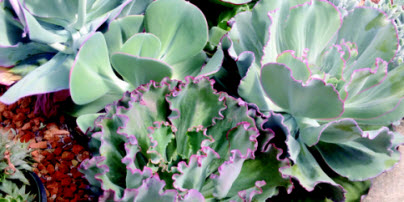Succulents are plants that store water in their leaves and stems to help them adapt to arid conditions. They often have waxy coatings and hairy leaves and stems. Sometimes, they have spines. The hairs, spines and waxy coatings are all devices designed to conserve moisture Hairs modify the climate directly next to the stem or leaf, preserving humidity and regulating temperature.
Some of these plants — the jade plant would be an example — even go so far as to keep their stomata, the pore-shaped breathing apparatus found on the underside of the leaves on most plants, closed during the day to avoid transpiration. They open at night to collect carbon dioxide which they use during the day to aid photosynthesis. These plants generally have shallow roots that grow close to the surface of the soil in order to capture every slight bit of moisture, from the lightest shower to heavy dew.
Until recently, succulents have been vastly overlooked in the garden, but now they are suddenly the plant du jour. Containers full of succulents project the height of sophistication, a look that strikes a sympathetic note with today’s spare design lines. Create geometric patterns with the varied shapes and colours of these plants. Plant a row of hens and chicks and echeveria in a low trough. Use low-growing sedums and different coloured succulents to create a mosaic inside a picture frame. Your imagination is the only limit to stunning design.
Busy homeowners and gardeners love these plants, because they are easy to grow and take so little care. Planted in the garden, you can forget them because they will look after themselves. You can plant succulents in the hottest, driest, stoniest part of the garden and they will thrive.
Indoors or in containers, they need infrequent watering. In winter, water them as little as once a month, depending on the size of the container. Mix potting soil with some sand, vermiculite, or perlite to improve soil porosity and drainage because succulents don’t like standing in wet conditions. Be sure the container has adequate drainage holes.
These plants are also very easy to propagate. Many of them will grow if a leaf or part of a stem is stuck in the soil.
Outdoors, yucca plants and aloe vera are two other perennial succulents you may not have thought about. Yucca filamentosa and Yucca glauca are both hardy to zone 3 and are very eye-catching when planted in a bed mulched with river stone. Their white flowers are beautiful and the plants are exotic and structural.
In the prickly pear cactus family, Opuntia fragilis, O. poryapantha and O. humifusa are native to southern Manitoba. They are an excellent addition to that sunny, hot spot at the side of the house where nothing else will grow.
Succulents are very good house plants. Burrow tail plants, kalanchoe, and Christmas cactus — even African violets — are examples of succulents you may already grow, but there are many new and exciting choices now available.
The conservatory at the International Peace Garden, 20 minutes south of Boissevain, has over 4,000 varieties to give you an idea of the possibilities. Our Farm Greenhouse near Portage La Prairie has over 800 different varieties of succulents to choose from.
Succulents deserve a bigger and better place in the home and in the garden. Give them a new chance this year.



